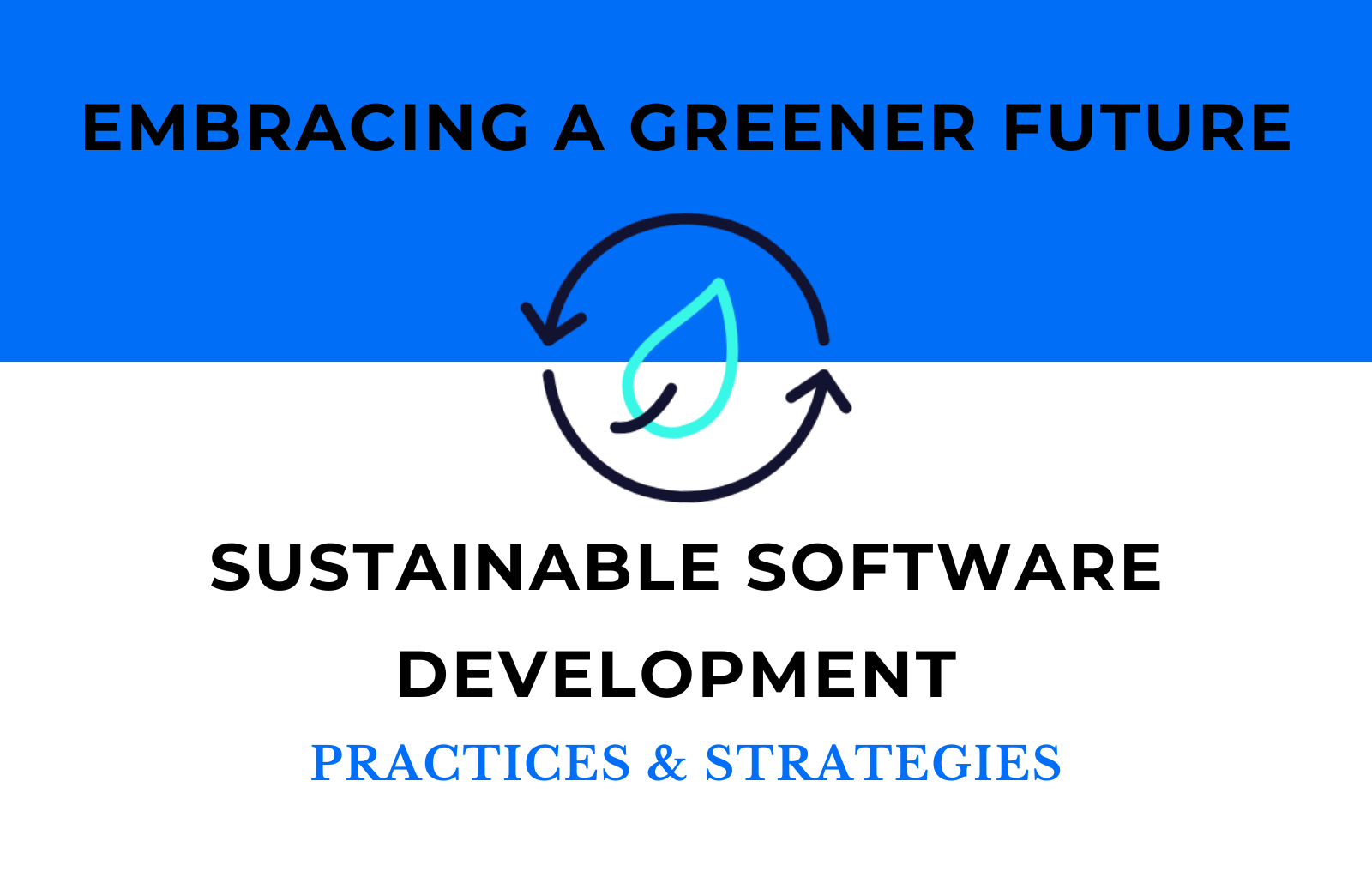Sustainable software development is an approach to software engineering that focuses on reducing the environmental impact of software applications. It encompasses a wide range of practices and principles that aim to minimise energy consumption, carbon emissions, and the overall ecological footprint of software products.
In this article, we will explore sustainable software development in depth, discussing its benefits and challenges, as well as the various techniques and strategies that can be employed to create greener software solutions. Throughout the article, we will cover various aspects of sustainable software engineering, green software development, and sustainability in software.
What is Sustainable Software Development?
a) Sustainable Software Engineering
Sustainable software engineering refers to the development of software applications that prioritise energy efficiency, carbon emissions reduction, and environmental sustainability. This field aims to minimise the negative long-term impact of software on the environment by focusing on energy-efficient design, carbon efficiency, and green software engineering practices.
b) Software Engineering Sustainability
Software engineering sustainability is the overarching goal of sustainable software development. By focusing on sustainability efforts, such as reducing energy consumption, carbon footprint, and environmental impact, software engineers can contribute to a greener future for the digital technology landscape.
Benefits of Sustainable Software Development
There are numerous benefits associated with sustainable software development, both from an environmental perspective and for organisations and end-users. Some of the key benefits include:
Reduced Environmental Impact
By focusing on energy efficiency and minimising carbon emissions, sustainable software development can significantly reduce the overall environmental impact of software applications. This contributes to global efforts to combat climate change and preserve the environment for future generations.
Cost Savings
Energy-efficient software can lead to cost savings for both organisations and end-users. Organisations can lower their energy bills and operational costs by reducing energy consumption. Similarly, end-users can benefit from decreased energy costs associated with running energy-efficient applications.
Enhanced Reputation and Brand Image
Adopting sustainable software development practices can help organisations enhance their reputation and brand image. Demonstrating a commitment to environmental sustainability can attract environmentally conscious customers, partners, and investors, providing a competitive advantage in the marketplace.
Regulatory Compliance
As governments and regulatory bodies increasingly focus on environmental issues, organisations may face stricter regulations and standards related to energy consumption and carbon emissions. Organisations can proactively address these requirements by adopting sustainable software development practices and ensuring compliance with evolving regulations.
Improved Application Performance and User Experience
Sustainable software development practices can also lead to improved application performance and user experience. By optimising software for energy efficiency, developers can reduce the application’s resource consumption, resulting in faster response times and smoother performance for end-users.
Attracting and Retaining Talent
A commitment to sustainable software development can help organisations attract and retain top talent in the software engineering field. Many software engineers are increasingly interested in working for companies that prioritise environmental sustainability and are eager to contribute to meaningful, positive change.
By embracing sustainable software development, organisations can reap these benefits and more, demonstrating their commitment to environmental sustainability while improving their software applications’ efficiency, performance, and cost-effectiveness.
Challenges in Sustainable Software Development
While the benefits of sustainable software development are clear, there are several challenges that developers and organisations must overcome to implement these practices effectively.
a) Balancing Performance and Energy Efficiency
One of the main challenges in sustainable software development is striking the right balance between performance and energy efficiency. Optimising software for energy efficiency can sometimes result in reduced performance, which can impact user experience and application performance. Developers must carefully consider the trade-offs between energy efficiency and performance, ensuring that the application meets its functional requirements while minimising its environmental impact.
b) Measuring and Quantifying Energy Consumption and Carbon Emissions
Accurately measuring and quantifying the energy consumption and carbon emissions associated with software applications can be a complex and challenging task. This requires detailed knowledge of hardware components, cloud services, and the software’s architecture and implementation. Additionally, there is a need for standardised tools and methodologies to measure and report these metrics consistently across the industry.
c) Integrating Sustainability Efforts into Existing Development Processes
Integrating sustainability efforts into existing software development processes can be challenging, particularly in organisations with established development practices and cultures. This may require a shift in mindset and the adoption of new tools and methodologies to ensure that sustainability considerations are incorporated throughout the software development lifecycle.
The Role of Sustainable Software Development in Environmental Sustainability
Energy Efficiency
Energy efficiency is a critical aspect of sustainable software development, as it reduces the overall electricity consumption of software applications. By optimising code, using energy-efficient programming languages, and minimising the energy usage of hardware, software engineers can create sustainable applications with lower carbon emissions and energy costs.
Carbon Footprint
The carbon footprint of a software application is the total amount of carbon dioxide and other greenhouse gases emitted due to its operation. Sustainable software engineering focuses on reducing the carbon emissions associated with software by improving energy efficiency, utilising green technology, and incorporating carbon-aware approaches to software design.
Environmental Impact
The environmental impact of software includes its carbon emissions, energy consumption, and contributions to the growth in cloud computing and cloud-based services. By adopting sustainable software development practices, software companies can minimise the negative impact of their products on the environment and promote long-term ecological sustainability.
Strategies for Sustainable Software Development
1- Energy-Efficient Programming Languages
Choosing an energy-efficient programming language can have a meaningful impact on the energy consumption of a software application. Some languages are inherently more energy-efficient than others, making them more suitable for green software engineering and carbon-aware applications.
2- Cloud Provider Selection
Cloud computing plays a significant role in sustainable software development. Software engineers can further reduce their application’s carbon emissions and environmental impact by choosing cloud providers and regions with the lowest carbon intensity.
3- Energy Proportionality
Energy proportionality is an important concept in sustainable software engineering, which aims to align the energy usage of hardware with its computational power. By optimising application performance and ensuring efficient hardware utilisation, developers can minimise the energy consumption of their software.
Best Practices for Sustainable Software Development
To achieve sustainability in software, developers need to adopt a sustainable approach and implement certain best practices. These include:
a) Energy Efficiency
- Optimise code to reduce the number of computations required, thus reducing energy consumption.
- Utilise energy-efficient algorithms and data structures.
- Choose energy-efficient programming languages and frameworks.
- Monitor and optimise the energy usage of your software application throughout its lifecycle.
b) Carbon Footprint Reduction
- Calculate the carbon footprint of your software application and identify areas for improvement.
- Optimise cloud-based services to minimise carbon emissions.
- Consider the environmental impact of the data centres where your application is hosted.
- Use public cloud providers that prioritise energy efficiency and carbon neutrality.
- Migrate to cloud regions with the lowest carbon intensity.
c) Environmental Sustainability
- Implement eco-friendly software practices, such as recycling, waste reduction, and sustainable sourcing of materials.
- Develop software applications that actively support environmental sustainability efforts, such as energy management, recycling, and waste reduction.
- Collaborate with other software companies and developers to share knowledge and best practices for sustainable software development.
d) Energy Proportionality and Hardware Efficiency
- Design software that scales its energy usage proportionally to its computational load.
- Develop hardware-efficient applications, making the most of the available resources and minimising energy waste.
- Optimise application performance to reduce the need for more powerful and energy-consuming hardware.
The Future of Sustainable Software Development
a) The Intersection of Climate Science and Software Engineering
As the climate crisis becomes more pressing, the software industry is increasingly turning to climate science to inform its approach to sustainable software development. By collaborating with climate scientists, software engineers can better understand the implications of their work and design applications that actively contribute to climate solutions.
b) The Growth of Green Technology in Software Development
Green technology is playing an increasingly significant role in the software industry. The growth of green techs, such as renewable energy sources and energy-efficient hardware, has the potential to revolutionise sustainable software engineering and further reduce the carbon footprint of software applications.
c) The Role of Public Cloud Providers in Sustainable Software Development
Public cloud providers are becoming more focused on sustainability issues, offering carbon-aware solutions and real-time power consumption data to help software engineers make greener choices. As the demand for cloud services continues to expand, public cloud providers will play a crucial role in driving sustainability efforts in the software industry.
d) The Expansion of Sustainable Software Development Education
The tech industry is increasingly recognizing the importance of sustainability in software development. As a result, there is a growing emphasis on integrating sustainable software engineering principles into educational programs and training resources for software developers.
Bottom Line
Building sustainable software is vital in addressing the software industry’s environmental impact. By adopting energy-efficient programming languages, optimising application performance, and employing green software engineering practices, software engineers can contribute to a more sustainable future. As the intersection of climate science and software engineering continues to grow, so too will the importance of sustainable software development in combating the climate crisis.
Zartis: Pioneering Sustainable Software Development Solutions
Zartis is a software development company focusing on bespoke, sustainable software engineering. We collaborate with clients to understand their unique needs and requirements, leveraging our expertise and experience to design and develop custom software solutions that fulfil their objectives. Our commitment to sustainable software development ensures that our products minimise environmental impact and promote long-term sustainability.
Our range of services includes:
- Product management: Developing and executing product strategies with a focus on sustainability
- QA, DevOps, and automation: Ensuring the seamless integration of sustainable software development principles throughout the software lifecycle
- Security: Implementing robust security measures to protect your software applications while maintaining energy efficiency and carbon-awareness
- Ongoing support and maintenance: Providing continued assistance to ensure the long-term sustainability of the software products we build
With Zartis, you can trust that you will receive high-quality, sustainable software development services tailored to your specific needs and requirements. Hurry up! Pick up your phone and contact us today to discover how we can help you on your journey towards a greener, more sustainable software future.





